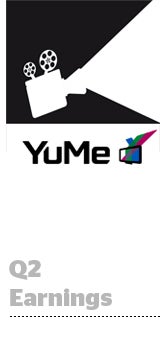 Though video ad company YuMe held to last quarter’s promise that it would release a programmatic ad stack, it did little to improve its Q2 2015 financial performance.
Though video ad company YuMe held to last quarter’s promise that it would release a programmatic ad stack, it did little to improve its Q2 2015 financial performance.
“We had a disappointing quarter,” said Jayant Kadambi, co-founder and CEO during a Monday earnings call. YuMe’s Q2 2015 revenue was flat – $40.4 million in Q2 2015, the same this time last year. This was lower than anticipated.
Ironically, the release of the programmatic technologies that would hopefully push YuMe closer to parity with its peers ended up hurting it. In focusing on the release of its programmatic offering (The DSP YuMe for Advertisers and the SSP YuMe for Publishers, all hooked into a proprietary data management platform), YuMe lost direct accounts.
Kadambi blamed these on “execution issues,” caused by YuMe’s “enthusiasm in programmatic and by taking the eye off the ball.”
He did not go into further detail but said that these issues affected “key account transitions” in the US and UK. “Going forward, I understand the execution issues, and I’ll focus on it more,” Kadambi said.
But don’t expect an immediate recovery: “Given the loss of a couple of customers, it’ll take some time to get those customers back.”
The company’s gross margins, at 42%, were also disappointing – and Kadambi attributed this to “an unusual spike in traffic acquisition costs.”
Here’s what happened, as per Kadambi: YuMe has what’s called a Placement Quality Index (PQI), designed to ensure it places video ads alongside the best audiences. In Q2, YuMe basically bought inventory that didn’t use PQI.
Why did it do this? Because client inventory guarantees – such as those around viewability and whatnot – were becoming onerous. With the addition of these “multiple requirements,” Kadambi said, “we made bad decisions on how we pick inventory.”
Ultimately, YuMe – which is now giving guidance on a quarterly basis – anticipates a Q3 revenue between $36 million to $40 million, a sequential loss. That doesn’t factor in revenue from new products, which presumably means its programmatic ad stack.
Kadambi did not specify how many advertisers or agencies have bought into its stack, though he said there was “early customer momentum” for its demand-side product (which is apparently way more mature than its SSP), and he believes it “can unseat existing DSPs.”
YuMe is banking on a flexible deployment model as a key differentiator: Kadambi said it can be configured for use by agency trading desks, as a managed service where buyers can add their own data in a private marketplace configuration and as a “customizable” video DSP that “will, over time, support fixed CPM and other pricing models.”
Regarding customer growth as a whole, 90% of YuMe’s revenue comes from clients spending at least $100,000. From June last year to June this year, that set of clients increased 17%, from 244 to 286. However, average revenue per customer during that timeframe decreased 6%, from $596,000 to $559,000.










